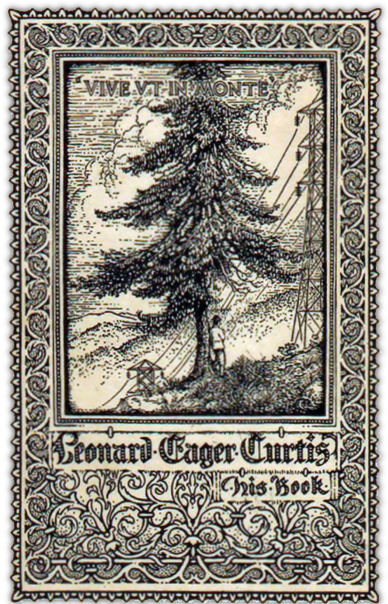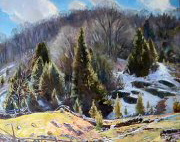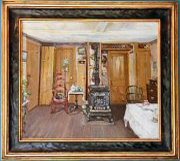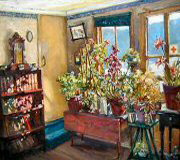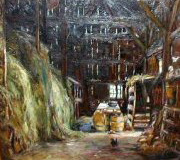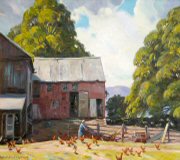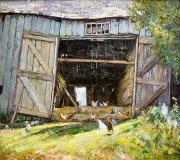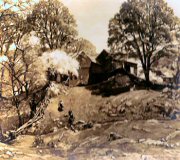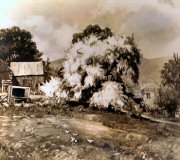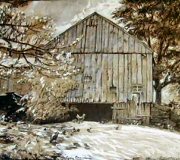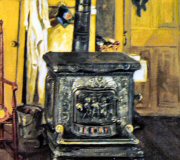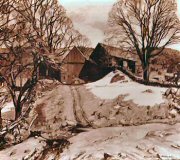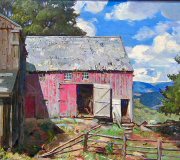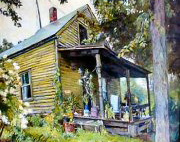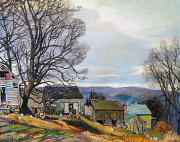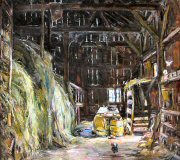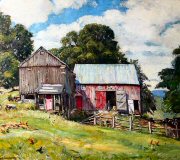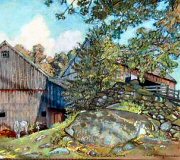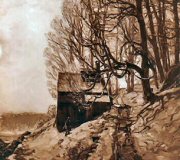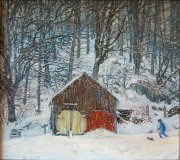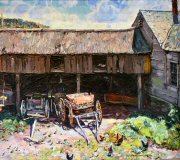Harrison Keach and The Keach Farm
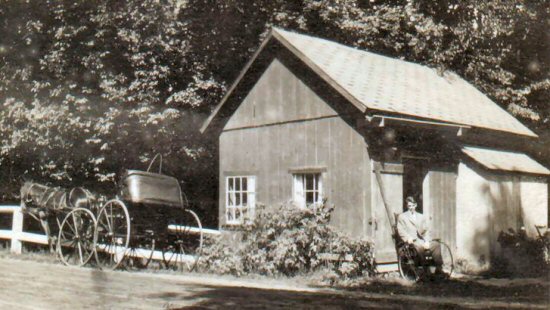
RSW in his wheelchair in front of Redgate, his first studio.
When Robert Strong Woodward first moved back to his old home town, Buckland, Massachusetts, he settled into an outbuilding on the farm of his Uncle Bert Wells located on the now Route 112 near the Mohawk Trail Regional School. He fixed up this old milk house into a studio and apartment and began his professional career to support himself.
Initially, he started to make bookplates & illuminations.
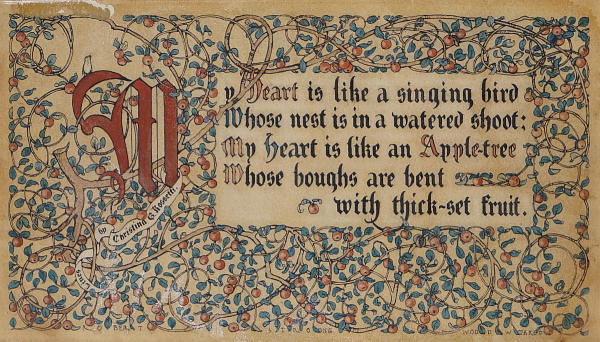
My heart is Like a Singing Bird, An illumination
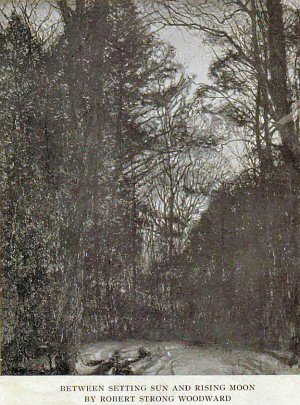
Then he started making large paintings in oil out of the rear windows looking into the deep woods and small stream. It was one of these which first won him professional recognition: Between Setting Sun and Rising Moon.
It was not long, however, before he realized that he had to get out into the countryside to capture the New England houses and farm scenes. At this time he had no nurse to tend to his physical requirements or handyman to assist him in getting around. Nevertheless, he purchased his first horse, Thomas à Kempis, and buggy. With much difficulty he learned to care for the horse and hook up the buggy and then take off for a trip, looking for a suitable country scene to paint.
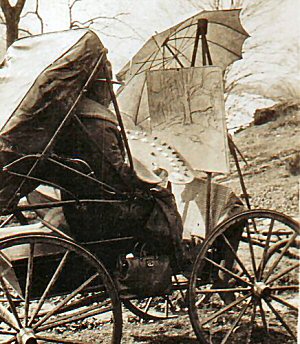
RSW in his buggy, painting.
Most of the harnessing of the horse was done sitting in his wheelchair, but some of it required literally dragging himself seated on the ground around the barn floor, and then pulling himself up on the side of a cooperative horse.
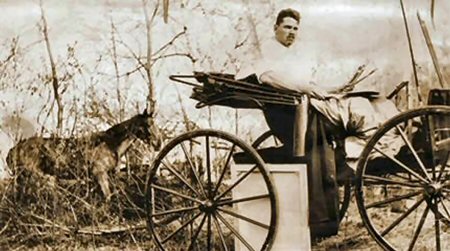
RSW in his buggy. Thomas à Kempis in the background
It was at this period of his life, while living in his first studio, Redgate, that he discovered the farm of Harrison Keach, located on the road to Charlemont out of Buckland Center. It had everything typifying a country farm: multiple barns and outhouses, pastures and stone walls, woodlands, a country farmhouse, apple trees, etc. He would hook up Thomas à Kempis, load his painting materials into the buggy, pack a lunch and head off for the day to the Keach farm to paint. Many of the paintings were made with him sitting in the buggy and Thomas à Kempis tied to a nearby tree.
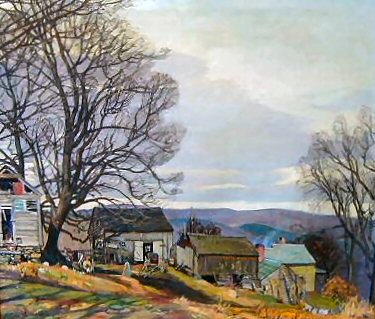
New England in November
The Keach farm as it appeared in about 1920.
The Keach farm was abandoned as a farm in the 1940s and the barns deteriorated and fell down. Only one of the barns and the original old house remain today.
During the early 1900s and into the 1920s RSW made frequent trips from Redgate to the Keach farm, usually 2 or 3 trips for each painting. Then he would spend another day or two touching up the finished painting back in his studio.
Below are some of the images of paintings made during this period of his life. Harrison had taken over the farm of his father, Fred Keach, and married a second cousin, Evelyn Clark of Hawley. His mother, Josephine (Josey) Clark, continued to live on the farm with them. See Josey feeding the chickens in the Woodward painting, The Farmyard, below.
Below are the images of some of the paintings of the old farm as it appeared in the late 1919s and 1920s. Scrapbook story continues below the gallery

Theme Gallery: Keach
Scrapbook Story Continued

April at Keach's Farm is a painting made on the Keach farm which to date we have not been able to trace down an image. Please click on the title to read what we know about this painting.
Early Sugaring 2 is another oil made on the Keach farm of the Harrison Keach sugar house, whereabouts now unknown.
We have no image of Hill Farm but it is most likely the Keach farm. The Woodward painting diary has the names of many other paintings which we have not discovered yet, but which we think many of them were made at the Keach farm. The Three Barns is the title of both an oil and a chalk drawing known to be made on the Keach farm.
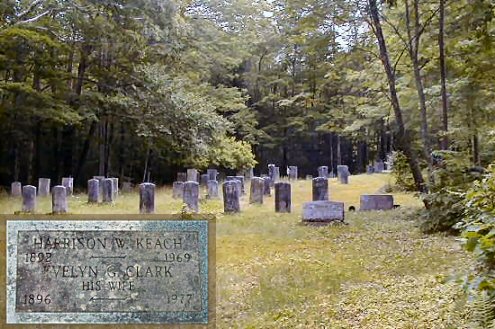
Hawley State Forest Cemetery. Inset, Harrison Keach Headstone
Harrison retired from farming in the early 1930s and took on the responsibility of caring for the three cemeteries in Buckland Center. He would walk from his home down to the center of town and spend all day raking, mowing the cemeteries and repairing the stones which were broken. He compiled a complete list of all of the inscriptions on the old stones, which somehow has become lost since his moving to Hawley and his death.
He was also interested in teaching the young folks in town how to shoot firearms, and held classes at his home for us kids who were interested in becoming marksmen. When I entered the army, I received my "marksman" pin on the first day. I had been well instructed. I was known as "Sgt. York" in my platoon during basic training!
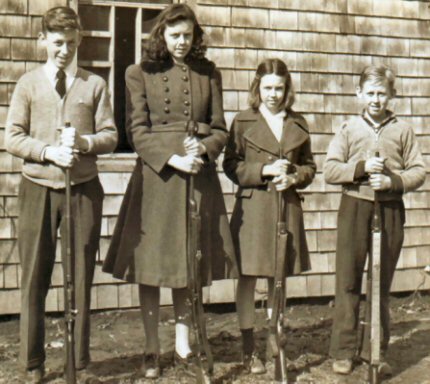
(L-R) Mark Purinton, Beverly Ward, Alma Ward and "Josh" Purinton
in front of Harrison Keach's house where he taught us to shoot.
To the left is a photograph of me (left), Beverly Ward, then Alma Ward, and my brother "Josh" (on the right) in front of Harrison Keach's house where he taught us to shoot a rifle. We would often lie on a mattress inside the house and shoot out the window behind us in the photo at a target 50 feet out in the yard. He taught us all the gun safety rules, and eventually entered us in shooting contests sponsored by the National Rifle Association.
Harrison was also a poet, one of the Robert Frost ilk. Collections of his works have been given to the Sons and Daughters of Hawley by Ellene Scott. One of Keach's poems, "The Road Men" was printed in the Edge of Hawley on page 35 of the issue of April, 1988. Below are two of his poems which have survived and were printed in the 1997 edition of The Edge of Hawley
Take Me Back Once More to Childhood
Take me back once more to childhoodLet me see my friends once more,
Take me to the little farmhouse
With the dahlias by the door.
It was from here they called the doctor
Early one September morn
But before he could get here
I was told that I was born.
Many times in early childhood
We came here to spend the day
And there always was a sadness
When we had to go away.
We would hitch the horse up early
And start in the cool of day
For we never tried to hurry
And were a long time on the way.
The horse was not built for speed,
But he probably did his best,
But I was young and impatient
When he stopped often to rest.
In a shady spot was a watering trough
Near the spring at the foot of the hill
Where the horse would drink,
and pause, and drink
'Till he had had his fill.
The old buggy wheels turned slowly
As we went up the long steep grade
And the sun and shadows mingled
As we went from sun to shade.
Up the long slope to the sawmill
We could hear the stream below,
As it came through rocky shadows
Ever onward in ceaseless flow.
At last we'd reach the village
By the hotel and the store.
The church bell would be ringing
And folks going in the door.
Then the horse would have more courage
And seemed not to mind his load
As he trotted past the schoolhouse
'Till he reached the old Stage Road.
When we drove up through the driveway
After traveling many miles,
The family was as glad to see us
And the young folks were all smiles.
At noon we gathered round the table
Aunts and uncles and the rest
The dinner was like Thanksgiving
With home cooking of the best.
In those times we were so happy,
We seemed not to have a care,
Everyone was so contented
It was a pleasure to be there.
And now that we are old and gray
The old home is no more.
The cousins that once lived there
Are all gone excepting four.
We'll never see Old Glory
O'er the schoolhouse any more,
And never here the church bell
And there is no hotel or store.
Time, like the stream below the mill,
Flows on and does not cease.
And though men come and go,
On these hills is enduring peace.
Harrison Keach, 1963
Those Times of Long Ago
Don't take me to ride in your motor carYour boat or airplane,
But hitch the horse to the buggy,
And we'll take a ride again.
We'll take the road past the beaver dam
That goes to my mother's old home.
We'll go over the hill past pastures and fields
Iin a land where she used to roam.
We'll take a narrow winding road
Where the autos seldom go,
And we'll drive along till we come to the stream
Where the cow slips bloom and grow.
We'll go past the place where the schoolhouse stood
Where they came to study or play,
But now only ashes are left
For fire took this landmark away.
Aunt Sally lived at the bend of the road
Where she raised her family of five,
And though Sally is gone and the house is gone
Some descendants are still alive.
Up the wooded slope in the pasture
There was a white black crystal rock,
And here sheep and lambs were feeding
For it was here we kept our flock.
Where ere the flock was feeding
It was easy for us to tell
By the lambs calling their mothers
And the tinkling of the bell.
At last we come to my mother's old home
Where the children played round the door,
But when they grew up and went away
The old home was no more.
Beside the driveway on the house
The morning glories grew,
And from the eaves of the woodshed,
The swift winged swallows flew.
Around the place the oxen worked
On the cart or on the plow,
These fields that were productive
Are all brush land now.
We must go down to the old trout brook
And cross o'er the wooden bridge.
We'll follow the road 'till we see the view
From up on top of the ridge.
Just beyond they laid out a graveyard
When the settlement was just begun
Here they brought the young and aged
When their work on earth was done.
We are going to stop when we come to Camp Rock
Where a family came long ago
And spent their first night in the hills
By the camp fire's flickering glow.
And now we'll take the road for home
As it winds up and down the grades
The silvery moon shines down on the road
Between spots and patterns of shade.
And now if I should close my eyes
These times of long ago
Will come back out of the past
With friends we used to know.
Harrison Keach
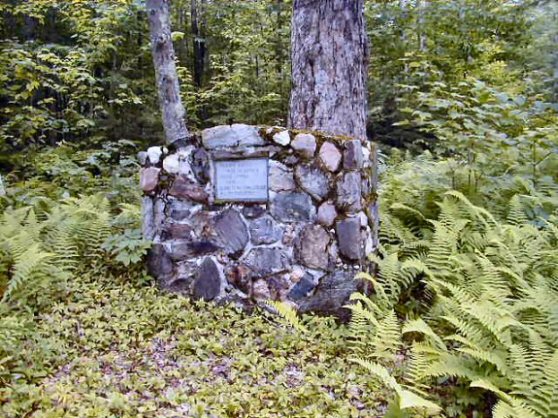
Plaque marking the Hawley State Forest Cemetery
After moving to Hawley Harrison again took on the care of the Hawley cemeteries. especially the old one located in the Hawley State Forest. The story of Harrison's funeral in the South Hawley Cemetery in the Hawley State Forest was lovingly written by a close friend Ellene Scott, and published in The Edge of Hawley Winter & Spring Edition of 1997 (please see text box below). Harrison's dogs, as they became old and died, were also laid to rest in the Keach plot here. Evelyn lived on some years later cared for at a home in Cummington.
HARRISON W. KEACH
|
potatoes. But most of
all, I remember his dogs, some of whom are buried in South Hawley Cemetery. Harrison died Feb. 5,
1969. He wanted to be buried in South Hawley Cemetery. How did Hawley do this?
David Scott and Ricky Chasse loaded up Ray Scott's snowmobile sled with shovels,
coffeepot, wood. bread, hamburg, onions and hot dogs, and headed for South Hawley Cemetery.
Once there, they built up a fire, and started digging. At noon, they cooked hamburgers, onions and hot dogs on a
heated shovel and had lunch. When finished, the grave was covered with evergreens against the snows. I have enjoyed writing this article and many thanks to you all and to Dr. Purinton. Signed Ellene Scott |
Robert Strong Woodward paintings of the Keach farm are located widely around the country today. We have found quite a few. Many we are still searching for, such as Spring Comes to the Keach Farm, and Hill Farm and Apple Blossoms.
A cousin of Harrison, named Herbert Keach owned and operated a farm on nearby Avery Road which burned down sometime in the 1920's. Click here to see the Keach family tree. RSW made at least three oil paintings on this farm. The stones of the cellar walls are still visible from the road as one rides by. Both paintings were widely published in the newspapers of the day with stories about the artist.

